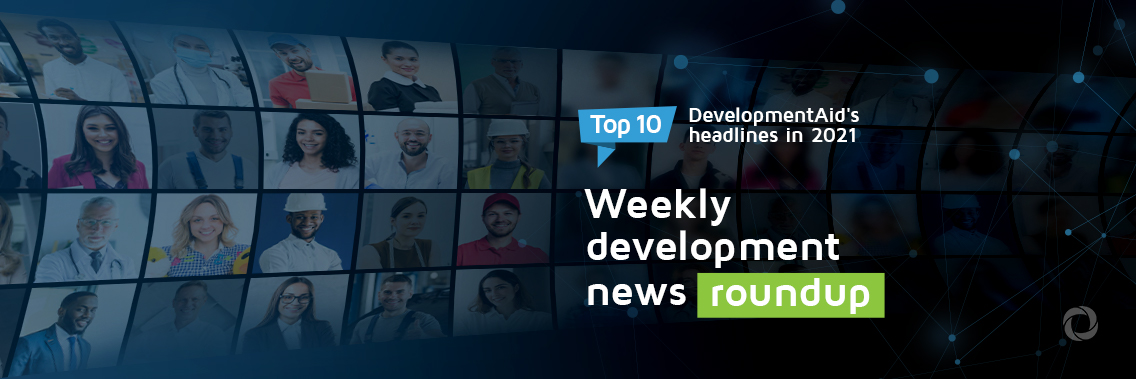A look at some of the biggest DevelopmentAid editorials of 2021. Here is what you missed from last year’s headlines:
 African countries continue to have the highest poverty rates in the world
African countries continue to have the highest poverty rates in the world
Whilst overall, poverty has been on the decline in Africa, the number of poor has continued to rise as a result of a growing population. According to a U.N. report, poverty decreased from 54% in 1990 to 41% in 2015, despite the increasing number of poor. This trend has continued until today and, as the current numbers show, African countries continue to have the highest poverty rates in the world.
Accurately tracking poverty-related data in Africa is made difficult by the lack of reporting from many countries with the quality of reports often being questionable. However, the statistics below represent the closest current estimates thanks to data from World Data Lab.
Read the full article here.
 Top 10 worst natural disasters over the last 100 years
Top 10 worst natural disasters over the last 100 years
Natural disasters have afflicted humanity from the dawn of time. Hurricanes, earthquakes, floods, and tsunamis lead to the deaths of around 60,000 people every year. According to the United Nations Office for Disaster Risk Reduction (UNDRR), the number of people seriously affected by these disasters has grown to 150 million with international aid reaching billions of US dollars to assist the affected countries. Over the last two decades alone, the Emergency Events Database has recorded 7,348 natural disasters around the globe.
The top ten most devastating disasters that have occurred around the world over the last 100 years have caused the death of nearly 6 million people.
Read the full article here.
 Top-10 safest countries to live in with lowest natural disaster risk
Top-10 safest countries to live in with lowest natural disaster risk
Millions of people around the globe are affected by natural disasters each year. Extreme natural events, such as floods, storms, or earthquakes, remote communities more vulnerable and increase the probability of forced displacement and migration. In addition to the natural disasters, the lack of coping and adaptive capabilities from authorities magnifies the risks associated with the affected communities becoming more susceptible to experiencing serious consequences in the aftermath of a disastrous event.
Having in mind the connection between the occurred disaster and the authorities’ ability to intervene and mitigate its consequences, DevelopmentAid’s article brings an overview of the TOP-10 countries that are safe to live in if a natural disaster occurs.
Read the full article here.
 Economics of externalities: Is food as cheap as we think it is?
Economics of externalities: Is food as cheap as we think it is?
While there are currently spikes in food prices on the world markets, it seems relevant to zoom in for a close-up on food prices in terms of consumer choice. This will allow an understanding as to what these prices actually consist of or, more to the point, what it costs to produce the food that consumers pay for. Opinions as to whether food is too cheap or too expensive diverge. However, looking at current food systems whereby the conventional industrial model is the main approach used to supply supermarkets is this, at the same time, having devastating impacts on the environment and rural livelihoods. The question therefore arises – is the price too high?
It is no secret that as consumers we seek to pay as little as possible for goods and services while expecting to get the maximum benefit from our purchase. What if the apparent benefit we obtain is tiny compared to what we, humankind, lose when we pay that price?
There are impacts that are not accounted for in the transaction, the so-called “externalities” which are the costs triggered by a producer but which are not financially incurred by that producer. In simple terms, the producer does not pay for polluting water and air (despite a polluter pays principle existing in some countries), for causing soil infertility, or for producing nutrient-poor and chemically contaminated food that creates considerable risks to consumers’ health. It is the consumer who subsequently indirectly absorbs all these costs.
Read the full article here.
 World’s biggest tire graveyard on fire. Cause, consequences and solutions | Expert’s Opinions
World’s biggest tire graveyard on fire. Cause, consequences and solutions | Expert’s Opinions
Last week was marked by news that shook the entire planet: the world’s biggest tire graveyard in Kuwait (where over seven million tires are stored) was on fire which could have transformed into a global environmental disaster if not extinguished quickly. The fire was so widespread that it was visible by satellite. In this context, more and more people are asking why the storing of such combustible materials is permitted in a country where temperatures reach 50C. We approached some environmental experts to share their opinion regarding this ecological disaster.
Read the full article here.
 Agostino Avanzi: Modern water supply and sanitation ought to rely on research and development to become sustainable
Agostino Avanzi: Modern water supply and sanitation ought to rely on research and development to become sustainable
Inhabitants of Ancient Rome were among the first urban residents to enjoy drinking water delivered straight to their homes. Today, Italian engineers continue their ancestors’ work by helping millions of people around the world to secure access to water and sanitation. However, while demand for this life-essential resource is constantly growing, billions still live in regions with absolute water scarcity.
This deficiency could be satisfied by transferring the results of research and development in modern aqueduct management to water supply utilities in developing countries although the process is not as easy as it may sound. Agostino Avanzi, an International Business Manager from Idrostudi LLC – a pioneer in combining research and development with on-field implementation, confirms this. “It is hard to be both a researcher and an engineer who implements the project but it is a unique opportunity to develop new models, with increased productivity and precision,” he says.
Read the full article here.
 PROFILE: “Solar Man” – India’s promoter of solar energy
PROFILE: “Solar Man” – India’s promoter of solar energy
When solar energy began to be developed in laboratories, Dr. S. P. Gon Chaudhuri, currently known in India as “Solar Man”, had already installed the first solar panels in poor villages. He did so strongly believing in their usefulness and absolute necessity and disregarded any doubts, including those of high-ranking officials. This meant that not only electricity could be provided to poor people (some had not had this at all before the 1980s and even into the 1990s) but also access to clean drinking water and proper sanitation, better education, improved economic activity, and, above all, little to no pollution as opposed to that caused by fossil fuel-based energy.
Read the full article here.
 Foreign aid and top donor countries in 2020
Foreign aid and top donor countries in 2020
Foreign aid refers to the voluntary transfer of financial capital, goods, or services via specific projects, programs, or relief operations from one country or international organization for the benefit of a recipient country or its population. This can take the form of economic, military, or humanitarian assistance and it can be bilateral (provided by governments directly) or multilateral (via various international organizations such as UNICEF).
The Organization for Economic Co-operation and Development (OECD) classifies bilateral foreign aid as Official Development Assistance (ODA) which is defined as flows of development assistance provided by the state and local governments, or by their executive agencies (e.g., USAID), to developing countries to promote sustainable economic development and welfare. It is important to mention that ODA is just one source of development assistance and it should not be viewed as a replacement for an effective domestic public management system. However, in times of socio-economic crises the need for development finance, such as ODA, is extremely high.
Read the full article here.
 Tanzania, Burundi, and Eritrea refuse to join the COVAX program
Tanzania, Burundi, and Eritrea refuse to join the COVAX program
While many African countries have begun to receive the first batches of COVID-19 vaccines within the COVAX program, others have refused to participate in the UN-led initiative to halt the coronavirus pandemic.
Within the framework of the COVID-19 Vaccines Global Access Facility (COVAX), as many as 31 African countries have received 60 million vaccine doses so far. At the same time, the World Health Organization (WHO) has highlighted that less than 2% of the total global number of vaccines have been administered in Africa. COVAX aims to deliver 600 million doses in total, enabling at least 20% of the African population to be vaccinated. In turn, African countries will have to spend US$12 billion to acquire sufficient doses to manage the pandemic effectively.
In the East African country of Tanzania, where approximately 68% of its 44.9 million citizens live below the poverty line of US$1.25 a day, the authorities have declined to participate in the COVAX program. The recently deceased President, John Magufuli, declared that his country did not need any vaccinations because “Vaccines are not good. If they were, then the white man would have brought vaccines for HIV/AIDS. We Tanzanians haven’t locked ourselves in and we don’t expect to lock ourselves down. I don’t expect to announce any lockdown because our God is living and He will continue to protect Tanzanians.”
Read the full article here.
 The main types and the evolution of international aid
The main types and the evolution of international aid
Foreign aid, budget support, humanitarian assistance, charity, bilateral aid – what do they all mean and why are there so many terms that apparently describe the same thing? If you have ever found yourself pondering that this article is for you.
There are three main types of development aid according to Dambisa Moyo, a Zambian economist, former World Bank consultant, and Goldman Sachs strategist. In her influential book, Dead Aid: Why aid is not working and how there is another way for Africa (2009), Moyo states that the three types of aid are humanitarian or emergency aid, systematic aid, also known as bilateral or multilateral aid, and finally, charity-based aid. All of it is aid, she says, but it differs in size, its source, the cause it is going to, etc. It also dictates the type of organization that can access it.
Read the full article here.

